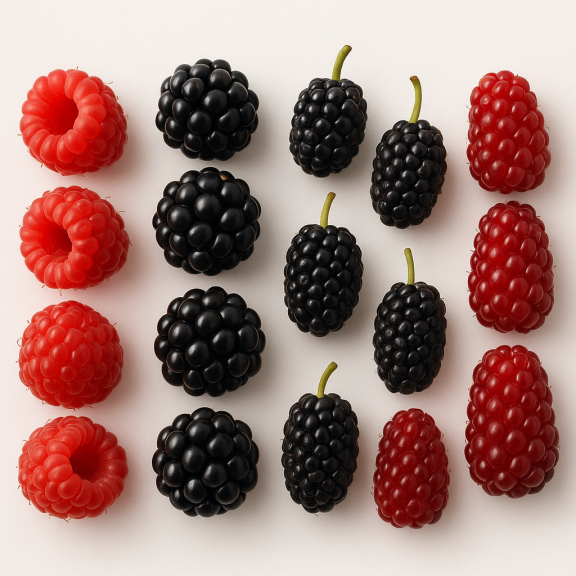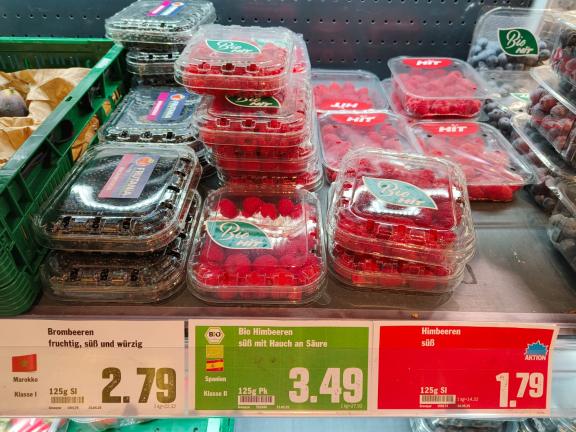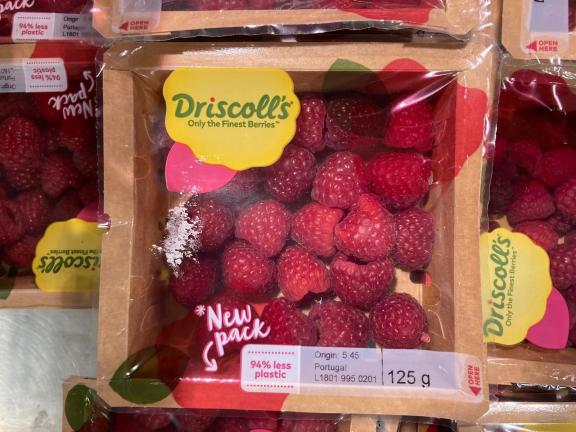
The European market potential for raspberries and blackberries
Europe is an attractive market for raspberries and blackberries. It has a strong level of demand year-round, and imports are increasing, especially from developing countries. Spain, the United Kingdom (UK), Germany, France, Poland and Switzerland have the most potential. As import volumes rise, Spain is becoming a key hub. Meanwhile, trends like demand for high-quality berries, health-conscious consumers, and sustainability requirements create opportunities and challenges for exporters.
Contents of this page
- Product description: raspberries and blackberries
- What makes Europe an interesting market for raspberries and blackberries?
- Which European countries offer the most opportunities for raspberries and blackberries?
- Which trends offer opportunities or pose threats in the European raspberries and blackberries market?
1. Product description: raspberries and blackberries
This factsheet focuses on:
- Raspberries (Rubus idaeus)
- Blackberries (Rubus)
Raspberries and blackberries are part of the rose family and grow on perennial bushes. Due to their small size and delicate skins, they are highly susceptible to damage in the supply chain. They are cultivated in Europe and imported from other countries during the off-season to supplement domestic production.
Table 1: Harmonised System (HS) codes for raspberries and blackberries
| HS code | HS code sub-classification |
|---|---|
| 081020: Fresh raspberries, blackberries, mulberries and loganberries | 08102010: Fresh raspberries 08102090: Fresh blackberries, mulberries and loganberries |
The HS codes used in this factsheet also cover mulberries (Morus) and loganberries (Rubus × loganobaccus). They look very similar to blackberries and raspberries (Figure 1). However, since these berries are rarely grown on a commercial scale, it is safe to assume that most trade under these codes is for raspberries and blackberries.
Figure 1: Raspberries, blackberries, mulberries and loganberries (from left to right)

Source: image generated using OpenAI's DALL·E tool, via ChatGPT
In this study, ‘Europe’ refers to the European Union (27), the United Kingdom and the EFTA countries (Iceland, Liechtenstein, Norway and Switzerland).
2. What makes Europe an interesting market for raspberries and blackberries?
With rising consumption and imports from developing countries growing, Europe is a key market for exporters of raspberries and blackberries.
High and growing demand for berries
European consumers want fresh, healthy and easy-to-eat food. Berries like raspberries and blackberries are becoming more popular because they are seen as healthy, have many uses and are available year-round. Raspberries and blackberries are also more popular because varietal developments in recent years have improved taste, aroma and shelf life. Berries are growing faster than any other type of fresh produce. However, there is still room for growth. To boost demand, new marketing campaigns highlight their health benefits, freshness and convenience.
This can be seen in the new European Berry Marketing Campaign. It will run for three years, starting in 2025. The campaign mainly promotes local fruit consumption and is supported by major European berry specialists like Berries Pride, Berrybrothers and BerryWorld. These companies grow berries in Europe and import them from other countries. Campaigns like this one can benefit suppliers from developing countries.
Raspberry consumption is generally higher than that of blackberries. However, with the introduction of new high-flavour varieties of blackberries and continued marketing efforts, the consumption of blackberries is expected to increase. Blackberries are the third-most popular berry among European consumers after blueberries and raspberries. However, they are also seen as the berry with the greatest growth potential. A lot of new developments in genetics are expected in the berry segment, especially for blackberries.
The countries with the highest volumes of raspberry and blackberry consumption in 2024 were the United Kingdom (34,000 tonnes), Spain (34,000 tonnes), Germany (26,000 tonnes) and France (17,000 tonnes). Other major, although slightly smaller, countries included Poland, Italy, Ireland and Austria.
Rising imports and the growing role of developing countries
European imports of raspberries and blackberries have grown in value and quantity over the past five years (Figures 1 and 2). From 2020 to 2024, the total value of imports rose by 45%, from €1,324 million in 2020 to €1,914 million in 2024. The imported quantity also increased by 17%, from 210,550 tonnes in 2020 to 246,565 tonnes in 2024. Most of the trade involves raspberries, in line with consumption patterns.
Raspberries have been one of the five fastest-growing fresh fruits in the European Union over the past decade. Between 2014 and 2023, import volumes increased by an average of 8% per year according to Fruit Logistica's 2025 European Statistics Handbook.
Source: Trade Map, May 2025
Source: Trade Map, May 2025
Most imports come from European countries, namely Spain, Portugal, the Netherlands, Germany, Poland and Belgium. However, developing countries also play a big role, as not enough is produced locally year-round. Climate conditions limit domestic production in northern and central Europe. This creates opportunities for exporters from countries with longer or complementary growing seasons. The share of total imports from developing countries has grown steadily. It went from 28.8% of the total volume in 2020 to 41.3% in 2024.
Source: own calculations with Trade Map data, May 2025
Imports from developing countries nearly doubled between 2020 and 2024. The value of these imports grew from €361.7 million in 2020 to €780.1 million in 2024. Quantities also increased, especially in major European import markets. Morocco is the leading developing country supplier and the top supplier overall. It surpasses even the main European suppliers. Other key suppliers from developing countries include Mexico, Guatemala and South Africa.
Imports of raspberries and blackberries from developing countries are expected to continue rising in both the short and long term. This trend is primarily driven by Morocco’s growing role as a key supplier. In addition to Morocco, other nearby sourcing countries are also expected to grow in importance. Meanwhile, imports from more distant origins may go down due to an increasing preference for more local and cost-efficient sources.
Tips:
- Try to supply the European market when local production is low, or during the off-season. Ask current and potential buyers which months are best to sell your berries. Prices are usually higher in the European winter. This creates good opportunities for countries with counter-seasonal production;
- Check supply calendars on European berry specialists' websites, such as Growers Packers (the Netherlands), to better plan your exports.
3. Which European countries offer the most opportunities for raspberries and blackberries?
Spain, the UK, Germany, France, Poland and Switzerland are the largest importers of raspberries and blackberries from developing countries in terms of value. These countries are also among the highest in terms of berry consumption within Europe.
Source: Trade Map, May 2025
Source: Trade Map, May 2025
Spain: The upcoming and main European importer
Spain is the second-largest producer of berries in Europe. It is the top importer and exporter of raspberries and blackberries. Spain grows a lot of berries. However, its production has decreased due to climate change. This means it needs to import more to meet local and European demand. In recent years, Spain has become a key country that re-exports berries to other parts of Europe. It now plays an important role as a trade hub for fresh fruit and vegetables. This creates new opportunities for suppliers from developing countries.
Most raspberries and blackberries imported to Spain come from Morocco and Portugal. Other European countries, like the Netherlands, also sell raspberries and blackberries to Spain.
In 2024, Spain imported 39,660 tonnes of raspberries and blackberries from developing countries, worth €268 million (78% of total imports). Raspberries made up more than 95% of that value. They were almost entirely from Morocco. While blackberries represented a small share, their value more than tripled, from €4.5 million in 2020 to €15.4 million in 2024. Morocco supplied nearly 90%, followed by Guatemala (9%) and Mexico (2%).
This trend highlights both opportunities and challenges for suppliers from other developing countries. While Morocco currently dominates the market, there is room for alternative origins to gain share. This is mainly due to uncertainties in local and European supply and the growing need to diversify sourcing. To make the most of this opportunity, suppliers should invest in efficient logistics and build strong relationships with Spanish importers. This means they can position themselves as reliable complements or even alternatives to Moroccan supply.
Ideal Fruits is a Spanish company that offers berries 365 days a year. It complements its own berry production with produce from abroad, mainly from Morocco, Portugal and Guatemala.
Tip:
- Read our study on exporting fresh fruit and vegetables to Spain for more information about the Spanish market and how to enter it.
United Kingdom: A growing market for berries
The UK is a promising and growing market for berry suppliers from developing countries. Berries are the best-selling fruit category in the UK. Volume sales have increased by 4.3% year-on-year. The percentage of consumers who buy berries is 85.3%. The total berry market first broke £2 billion in early 2025. This growth in consumption was boosted by campaigns like Love Fresh Berries. These campaigns promote the health benefits and all-round availability of berries (strawberries, blueberries, raspberries and blackberries) in the UK.
According to an EY report for British Berry Growers, supermarkets sell 97.7% of berries in the UK. Six retailers are responsible for 76.9% of sales: Tesco, Sainsbury’s, ASDA, ALDI, Morrisons and Lidl. Strawberries are the top-selling berry, followed by blueberries, raspberries and blackberries. Raspberry sales grew steadily, with an 8.5% increase in volume, from 28,727 tonnes in 2019 to 31,173 tonnes in 2023. Blackberry sales also grew slightly, from 3,807 tonnes in 2019 to 3,882 tonnes in 2023. This shows that blackberries are a niche with a stable market position.
Raspberry and blackberry imports from developing countries rose from 3,430 tonnes in 2020 to 23,247 tonnes in 2024. This made up more than 60% of total imports (35,883 tonnes). Most of these imports came from Morocco. Morocco provided 89% of raspberries and blackberries from developing countries and 58% of the total. As in all European countries, raspberries dominated imports, but blackberries are growing fast.
British raspberries are in season from June to November. The rest of the year, the UK mainly imports raspberries from Morocco, Spain and Portugal. Blackberries sold in the UK mainly come from Morocco, Guatemala, Mexico, Spain and Portugal. The British blackberry season runs from July to November and peaks in August. The UK is open to airfreight produce. This is why you can find raspberries or blackberries from overseas origins, such as South Africa and Kenya, more often than elsewhere in Europe.
Supermarkets in the UK usually have dedicated suppliers that take care of import and distribution. They are good clients for you to target. DPS Ltd, for example, supplies the UK’s biggest supermarket chains. Primafruit supplies Waitrose & Partners, a premium British supermarket. British supermarkets usually require SMETA and other certifications to show that berries are grown ethically and sustainably. Be prepared to show compliance or detailed plans to get certified.
Tips:
- To find potential buyers, check British Berry Growers' member list. Their members supply a large share of the berries imported into the UK;
- Check the websites of the British supermarkets mentioned above to see packaging, varieties, sizes, origins, prices and different premium attributes. Read customer reviews to understand what they find important;
- Pay attention to innovations in the berry category in the UK. For example, Driscoll’s recently opened Europe’s largest dedicated berry development facility. It combines R&D, production and packing on site.
Germany: A steady market for imported berries
In Germany, raspberries and blackberries are available year-round. Outside the local harvest season, which runs from June to October, supermarkets rely heavily on imports to meet demand. Domestic production only covers a small share of consumption. In the 2023/24 season, Germany’s production only covered 7.1% of raspberry consumption and 13.7% of blackberries and gooseberries. In 2024, total imports of raspberries and blackberries reached 41,782 tonnes. 35,697 tonnes were raspberries, and 6,512 tonnes were blackberries.
Morocco was the leading supplier. It exported 19,738 tonnes to Germany, followed by Portugal (7,557 tonnes) and Spain (6,301 tonnes). While Portugal maintained stable volumes, Spain saw a decline in recent years but showed a slight recovery in 2023 and 2024. Other key suppliers include Poland, the Netherlands and Mexico. Mexico mainly exported blackberries. The share of developing countries in total import volume was 51% in 2024; 93% of this came from Morocco.
According to the German Federal Office for Agriculture and Food (BLE), per capita consumption in the 2023/24 marketing year was 1 kg for raspberries and 0.2 kg for blackberries and gooseberries. These figures have remained stable over the past three years. This suggests consistent consumer interest and a steady market for imported berries. You should keep in mind that Germany is a demanding market. Discount supermarkets are very popular, and they do not sacrifice quality to offer low prices.
The German market focuses on organic production, and many retailers strongly market organics. However, a study by Roamler found that few organic raspberries and blackberries are sold. There were exceptions in the middle to upper price range supermarkets, such as Hit (Figure 7), EDEKA, REWE and tegut…. At tegut…, the share of organic raspberries between January 2023 and March 2024 was 12%. The share of organic blackberries was 38%. Developing country suppliers with certified organic berries can make the most of this by targeting premium retailers.
Figure 7: Conventional and organic raspberries and blackberries assortment at a Hit supermarket in Germany

Source: Dana Chahin
Tips:
- For more information about the German market and how to enter it, read our study on exporting fresh fruit and vegetables to Germany;
- Visit the websites of German berry specialists that offer year-round supply, such as Widmann. You can interact with them and other potential buyers at Fruit Logistica, a trade fair hosted yearly in Berlin.
France: Growing demand to be met by imports
The French raspberry and blackberry market has promising opportunities for exporters from developing countries. Consumer demand for these berries has become a year-round trend in France. However, domestic production cannot meet this demand due to labour-intensive cultivation and limited planting areas. Exporters from developing countries can capitalise on this by offering high-quality raspberries and blackberries, especially during periods when local supply is low.
Import volumes have grown steadily over the past five years. Portugal, Morocco and Spain are the top three suppliers. Together, they account for around 90% of total imports, with each contributing roughly one-third. In 2024, France imported 29,651 tonnes of raspberries and blackberries. 90% of those imports were raspberries. Developing countries have a 35% share of the total import volume, and Morocco provides 85% of this portion.
There are notable differences in where French retailers source their berries. According to 2023/2024 data from Roamler, Naturalia sources most of its raspberries (73%) and blackberries (67%) from French producers. Meanwhile, chains like SPAR and Lidl rely more on Morocco for raspberries and Chile for blackberries. Naturalia also leads in organic options. 95% of its raspberries and 67% of its blackberries are organic. This reflects Naturalia’s commitment to organic, local and ethical sourcing.
For suppliers from developing countries, this diversity in sourcing strategies presents opportunities. Mainstream retailers like SPAR and Lidl offer opportunities for volume-driven exports. Premium chains like Naturalia require certified organic and more sustainable sourcing. Tailoring supply strategies to each retailer is key to gaining and maintaining access to the French market.
Examples of French importers are Gaia International and Agence Laparra. For them, berries are one of the main product categories. Many French importers have a presence in Rungis, the leading French wholesale market.
Tip:
- Check the Rungis supplier directory. Use the translator function in your browser to filter results by ‘Spécialiste en Fruits rouges’, ‘Framboises’ or ‘Moures’. This will display wholesalers specialised in red fruits (berries), raspberries or blackberries.
Poland: Leading producer with growing imports from developing countries
Poland is the leading producer of berries in Europe. Most raspberries and blackberries in local supermarkets are grown in Poland. The country has an ongoing campaign to promote the consumption of Polish berries. It markets them as superfoods. Although the campaign only aims to promote Polish produce, consumers have started to consume berries all year round. Poland has seen steady growth in imports over the past five years. This is expected to continue.
In 2024, Poland imported 6,584 tonnes of raspberries and blackberries. The top suppliers were the Netherlands (1,829 tonnes), Germany (1,323 tonnes) and Moldova (1,011 tonnes). The latter was the most important developing country supplier. Morocco (816 tonnes) and Ukraine (436 tonnes) were also key non-EU sources. The share of developing countries in the total import volume of raspberries and blackberries was 35.2%.
Data at the retail level from the 2023/2024 Roamler study shows that most imported raspberries and blackberries sold in Polish supermarkets come from Morocco and European countries. This is the same as in Portugal, Spain and the Netherlands. No other developing countries were visible in retail product offerings. This suggests that imports from other developing nations (such as Moldova) may be directed towards the processing industry or re-exported. This makes sense, especially because much of Poland’s domestic berry production is intended for export (mainly frozen).
Organic options in Polish retail are limited. The Roamler study found no organic blackberries on shelves, and only a modest share of organic raspberries (15%) available at Lidl, for example. However, Polish supermarkets are becoming stricter in terms of maximum residue levels (MRLs). Many are adopting requirements stricter than European law. In some cases, the requirements for the number of allowed substances are stricter than Lidl's. Lidl is known for having the strictest MRL requirements in Europe.
Polish grower Polskie Jagody is a leading berry supplier to the European market. It is also an importer to the Polish market outside of its growing season. Berrytrade is a Polish trader that specialises in supplying berries to Polish supermarkets and other European markets. In terms of certifications, many Polish importers and retailers require at least GLOBALG.A.P and BRC for the packhouse. However, they are not yet strict in terms of social and environmental certifications.
Tip:
- Visit the website of the biggest Polish retailer Biedronka, which has a year-round offer of berries. Use the translator option of your browser to check their ‘Best Deals of the Week’ or their online grocery shopping site. Look for the words ‘Jezyny’ and ‘Maliny’. These words mean ‘blackberries’ and ‘raspberries’, respectively.
Switzerland: A small niche market that values sustainability
Raspberries and blackberries are becoming more popular among Swiss consumers. However, it does not grow enough of these fruits to meet demand. Most of the volume is imported from Spain (72%) and other European countries. Morocco is the only relevant developing country supplier, with a 14% share. If you want to export to Switzerland from a developing country, it is important to focus on sustainability. Many Swiss people are worried about the environment, so they prefer local or eco-friendly products.
In Switzerland, raspberries and blackberries can be harvested from June to September. Some varieties of raspberries even last until the first frosts at the end of autumn. During this period, consumers prefer local produce. Local farmers often run promotional campaigns to emphasise the benefits of buying locally. If you want to have a chance in this market as an overseas supplier, you should focus on the period outside of the local season.
Switzerland has special import rules during the local season. There is a tariff quota between June 1 and September 14 for raspberries, and from July 1 to October 31 for blackberries. During this time, only a limited quantity of berries can enter the country with preferential import taxes. After that limit is reached, extra imports are subject to higher duties. In 2024, Switzerland imported 4,635 tonnes of raspberries and blackberries. Of these, 3,832 tonnes (83%) were raspberries imported between September 15 and May 31, outside the local season.
Switzerland is a small and niche market. To succeed, you need a good local partner and a product that meets Swiss expectations. This means meeting high standards for sustainability. For example, the Swiss company Giovanelli imports berries and other fresh products. On its website, it states that fair trade and certifications like Bio Suisse and Fairtrade are very important. Another Swiss importer trading berries is Prodivec. It only imports raspberries from Morocco.
Tips:
- Check the Swiss seasonal calendar to identify when your product might have higher chances of success;
- Check the websites of supermarkets like Migros and read customer reviews. You will notice a lot of organic products and mixed-berry packaging options.
4. Which trends offer opportunities or pose threats in the European raspberries and blackberries market?
Several key trends are shaping the European market for raspberries and blackberries. Consumers increasingly demand high-quality, flavourful berries, and prioritise health and sustainability. At the same time, importers need to balance the preference for locally grown produce and the need to meet year-round demand.
Desire for high-quality berries: Sweet, aromatic and long-lasting
The European market is increasingly shifting toward high-quality berries with superior taste, aroma, appearance and shelf life. Consumers pay more if the product is good and comes in the right packaging. Varietal innovation is driving this trend. Cultivars are being developed that are more resilient to climate change and diseases, and that offer enhanced sweetness and firmness.
Exporters that adopt improved varieties can access premium retail segments and better differentiate their offerings. For example, compact raspberries with larger drupelets are becoming more popular. Cultivars are being developed with these qualities, while keeping the highly appreciated aroma and improving shelf life. For blackberries, the introduction of sweet varieties has been a game-changer and will continue to drive consumption. An example of a sweet blackberry variety is the Sweet Royalla.
Remember that you need to balance several factors in choosing the right variety. The most important factor is that consumers will like it. Other factors, such as waste, yield and water use (depending on your growing area) cannot be overlooked. In the short term, demand will continue to grow for sweeter and more visually appealing berries. In the long term, climate-resilient and resource-efficient premium varieties will shape the future of production and retail positioning.
Tips:
- Monitor the development, launch and success of varieties by visiting the websites of breeders and genetics companies, such as Planasa, Global Plant Genetics and G-Berries. For example, G-Berries has developed ‘easy’ raspberry varieties. These are easy to pick, reducing harvesting costs;
- Ask advice from breeders to find your variety. You can use tools like Planasa's to discover the right varieties for your region;
- Read this summary of a LinkedIn survey published by ItalianBerry. It highlights what consumers and raspberry sector experts want for the future of raspberries.
Sustainability as a market entry requirement
European consumers and retailers are increasingly concerned with how berries are produced. They focus on environmental impact, working conditions and transparency throughout the supply chain. Sustainability, fair labour and ethical sourcing have become standard rather than of added value. Organic farming practices and zero-residue berries have become essential for health and sustainability-conscious European consumers, especially in northern Europe.
For developing country exporters, this trend means that compliance with environmental and social standards is a must. Certifications, traceability systems and transparent storytelling about producers help build trust. The use of sustainable packaging is increasingly expected by consumers. Packaging options that are biodegradable, recyclable or derived from renewable materials must preserve the product’s integrity, reflect its premium position and meet environmental expectations.
Figure 8: Driscoll’s raspberries in sustainable packaging, available at Swedish retailer City Gross

Source: ICI Business
Organic is expected to grow as a trend. However, the organic supply of raspberries and blackberries in Europe comes from within Europe or neighbouring countries, like Morocco and Serbia, from where land transport is possible (see below). There is limited organic sourcing from developing countries further away.
This creates an opportunity for exporters who can identify varieties suited to organic farming and that can endure long transit times. However, as the combination of airfreight and organic is difficult, you should talk to prospective buyers before investing in organic certification.
Organic imports of raspberries and blackberries in the EU
According to the latest available data by TRACES, imports of organic raspberries and blackberries from non-EU countries declined between 2018 and 2023. Import volumes were nearly identical in 2023: 227 tonnes for raspberries and 225 tonnes for blackberries. Serbia was the sole supplier of organic blackberries. The Netherlands (152 tonnes) and Italy (75 tonnes) were the main EU destination markets. For organic raspberries, Serbia and Morocco each exported around 100 tonnes, also primarily to Italy and the Netherlands.
The organic segment is stronger in Western and Northern Europe. According to FiBL data, Denmark, Switzerland and Austria have the largest organic retail sales shares and per capita consumption in Europe. In terms of total organic retail sales, Germany and France are the largest markets. Fresh fruit is often one of the main consumption categories in these countries. Berries are an important organic fruit.
Tips:
- Read this article on Infia Packaging’s sustainability initiatives. The company specialises in plastic packaging solutions for the berry sector;
- Explore storytelling examples of growers from leading berry companies such as BerryWorld. Pay attention to how they highlight certifications, sustainable growing and harvesting practices, and the people behind the produce;
- Look at how Driscoll’s Europe displays information about its Spanish and Moroccan organic raspberries and blackberries on its website.
Health-conscious consumers will continue to drive consumption
Health and wellness trends will continue to strongly influence food consumption in Europe. Berries are already associated with health benefits. However, there is a growing need for clearer communication about their nutritional value and role in a healthy diet. This was a key takeaway from the 2025 Fruitnet Berry Congress in the Netherlands. Young consumers respond well to clean-label products with claims about natural sweetness and health benefits.
Exporters can make the most of this trend by communicating their products' health benefits to European buyers. Nutritional information and documented health claims support storytelling throughout the supply chain. Importers value this type of marketing support. It also helps position berries better at supermarkets with health-conscious consumers.
As fresh berries are highly perishable but very desirable for their health benefits, some growers and EU-funded projects are investing in processing options. This includes options like healthy berry snacks with no added sugar, salt or preservatives. While this opens new market segments for you to explore, it is also a competitive threat to the fresh berry category. As a result, investing in innovative cultivars that have a longer shelf life and are of high quality is very important to grow in the fresh segment.
Tips:
- Explore how the Dutch marketer and importer Berries Pride communicates nutritional benefits and other information. Look at how it uses the packaging of raspberries and blackberries. Understanding their messaging can help you better support your clients by providing information they can pass on to retailers;
- Consider attending the Fruitnet Berry Congress. This is a high-level meeting point for the industry. Check the 2025 agenda to browse trending topics and leading players and monitor upcoming editions of the event.
Preference for locally produced berries versus year-round demand
The growing consumption of local and seasonal products has been a trend in Europe for several years. When in season, consumers prefer locally grown products. This is also the case for raspberries and blackberries. Retailers prefer local production and sourcing when possible.
However, the growth of year-round berry demand is expected to continue. Consumers and supermarkets want berries, year-round, regardless of origin. This means European buyers actively look for alternative origins to fill seasonal gaps and minimise risks. Moreover, with climate change causing extreme weather conditions that negatively affect yields, diversifying origins is crucial in sustaining demand for fresh products.
Tips:
- Enter the European market during the off-season or during periods of product scarcity. If you do not, your product will compete directly with local produce;
- Listen to the ‘BerryTalks’ podcast on YouTube or Spotify. In it, leading global players share insights on trends, challenges and innovations in the berry industry. It is a great way to stay informed.
Dana Chahin carried out this study on behalf of CBI.
Please review our market information disclaimer.
Search
Enter search terms to find market research

